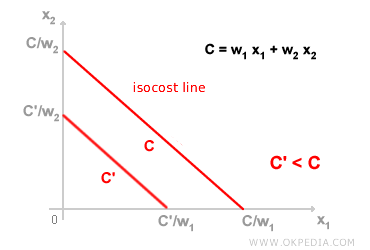Isocost
An isocost represents all the possible combinations of two production inputs that result in the same total production cost. Given the input prices (w1/w2), the isocost line shows which combinations of inputs (x1, x2) can be purchased while keeping total production cost (C) constant. Graphically, the isocost equation can be plotted on a Cartesian plane. In the simplest cases, it appears as a straight line (isocost line), while in more complex scenarios, it may take on curved or non-linear forms (isocost curve). Along an isocost line, total production cost remains unchanged as input quantities vary. The farther an isocost line is from the origin, the higher the production cost it represents, while lines closer to the origin correspond to lower costs. The diagram below illustrates two isocost lines: the first corresponds to production cost C, and the second to cost C', where C > C'.

The intercepts of isocost lines on the graph’s axes indicate the maximum amount of a given production input that can be used given the total budget. For example, with a total cost C and two inputs X1 and X2 priced at w1 and w2, respectively, the X1-axis intercept is given by C/w1, while the X2-axis intercept is C/w2. The slope of the isocost line is the absolute value of the ratio between input costs, w1 / w2, and is known as the marginal rate of transformation. A collection of isocost lines, each corresponding to a different total cost, forms an isocost family.
